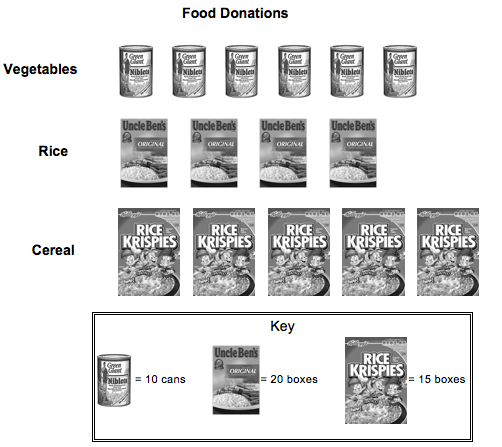Extended Time Probability

- 1.
The graph below shows how much food has been donated to the local food pantry. Why is the graph above misleading?
- A.
The graph does not include all items donated to the good pantry.
- B.
Each symbol is worth a different amount.
- C.
Each symbol is a different picture
Correct Answer
B. Each symbol is worth a different amount. -
- 2.
The bar graph shows the average number of hours that people in different age groups spend watching television each week. Which statement best describes why the graph could be misleading?
- A.
The age intervals are too broad.
- B.
The title of the graph is misleading.
- C.
The intervals on the vertical scale are not uniform.
- D.
The bar lengths do not correctly reflect the data.
Correct Answer
C. The intervals on the vertical scale are not uniform. -
- 3.
Josie’s older sister works at a computer store. She wants to ask her boss for a raise, so she makes a graph to show how her computer sales have increased over the past six months. The boss thinks that Josie’s graph is misleading. Which of the following best explains why the graph is misleading?
- A.
The intervals are not uniform on the y-axis.
- B.
The data set is too small.
- C.
The intervals on the y-axis make the increase in sales appear significant.
- D.
The data should be displayed as a circle graph rather than a line graph.
Correct Answer
C. The intervals on the y-axis make the increase in sales appear significant. -
- 4.
A clothing store surveyed 100 boys aged 12 to 16 about their preferred T-shirt colors. The results are shown in the table. If the store uses only these data to order T-shirts, which conclusion best reflects the data collected?
- A.
More than half of each order should be orange T-shirts.
- B.
More than half of each order should be purple T-shirts and orange T-shirts.
- C.
Only purple T-shirts and orange T-shirts should be ordered.
- D.
About a third of the order should be green T-shirts and yellow T-shirts.
Correct Answer
B. More than half of each order should be purple T-shirts and orange T-shirts. -
- 5.
The USA Track and Field Committee published the following report illustrating the comparison of lap speed and finishing placement of several top relay teams. Based on the bar graph below, which of the following conclusions is most accurate?
- A.
The first-place team was twice as fast as the fourth-place team.
- B.
The fastest time for the 200-meter relay is 7 meters per second.
- C.
The first-place and second-place teams were closest in time to one another.
- D.
Every runner on the first-place team ran faster than the runners on the second-place team.
Correct Answer
C. The first-place and second-place teams were closest in time to one another. -
- 6.
Mrs. Dulock surveyed one of her classes to find out their favorite ice cream flavor. There are 30 students surveyed. The results of her survey are listed in the frequency chart below: Which of the following statements cannot be supported by the data in the table to the left?
- A.
A. About 17% of the students surveyed prefer vanilla ice cream.
- B.
B. About two-fifths of the students surveyed prefer either chocolate or strawberry ice cream.
- C.
C. If Mrs. Dulock surveyed all of her classes (120 students), you would expect about 32 students to say that they prefer chocolate chip ice cream.
- D.
D. About 30% of the students surveyed prefer chocolate chip ice cream.
Correct Answer
B. B. About two-fifths of the students surveyed prefer either chocolate or strawberry ice cream. -
- 7.
The graph below shows the number of Olympic medals won by each country in the summer of 2004. Why is the graph misleading?
- A.
There is no x- or y-axis.
- B.
The countries should be in alphabetical order.
- C.
It does not include the medal count from the winter Olympics.
- D.
Each medal on the picture graph does not represent the same amount of medals won.
Correct Answer
D. Each medal on the picture graph does not represent the same amount of medals won. -
- 8.
Mrs. Henderson gave her students a math test and recorded the scores in the chart below. Based on the information in the chart, which of the following is NOT a valid conclusion?
- A.
Two students made a grade of 82.
- B.
If 70 above is considered passing, the number of grades below passing is less than the number of grades above passing.
- C.
There were more grades in the 90s than there were grades in the 80s.
- D.
The total number of grades in the 70s and 80s combined is the same as the number of grades in the 90s.
Correct Answer
D. The total number of grades in the 70s and 80s combined is the same as the number of grades in the 90s. -
Quiz Review Timeline +
Our quizzes are rigorously reviewed, monitored and continuously updated by our expert board to maintain accuracy, relevance, and timeliness.
-
Current Version
-
Mar 21, 2022Quiz Edited by
ProProfs Editorial Team -
May 05, 2013Quiz Created by
Lesliedulock
- Algebra Quizzes
- Arithmetic Quizzes
- Calculus Quizzes
- Data Handling Quizzes
- Decimal Quizzes
- Discrete Mathematics Quizzes
- Equation Quizzes
- Fraction Quizzes
- Function Quizzes
- Geometry Quizzes
- Graph Quizzes
- Measurement Quizzes
- Multiplication Quizzes
- Number Quizzes
- Percentage Quizzes
- Place Value Quizzes
- Problem Solving Quizzes
- Ratio Quizzes
- Shape Quizzes
- Trigonometry Quizzes
 Back to top
Back to top





.png)
.png)
.png)
.jpg)
.png)